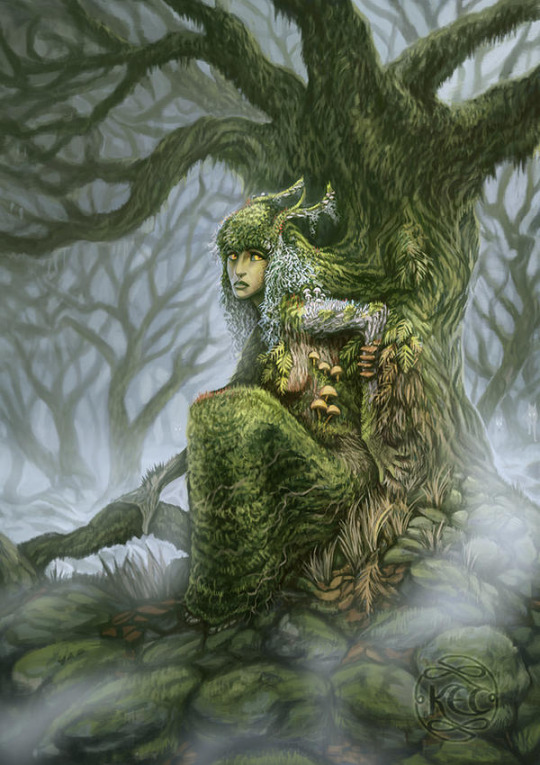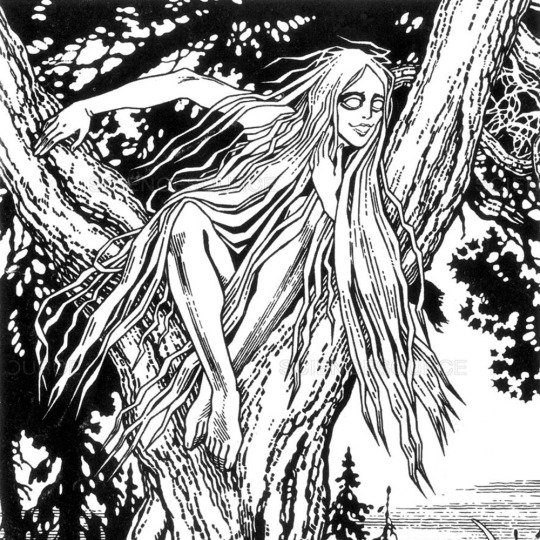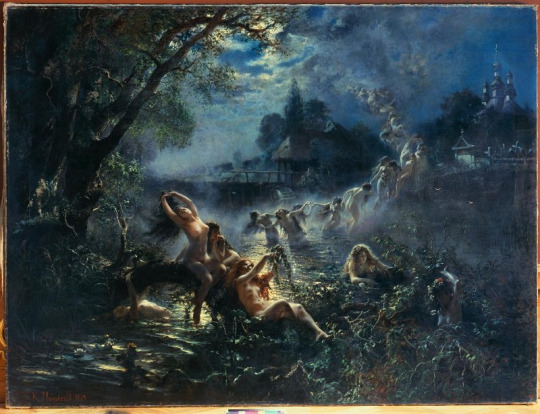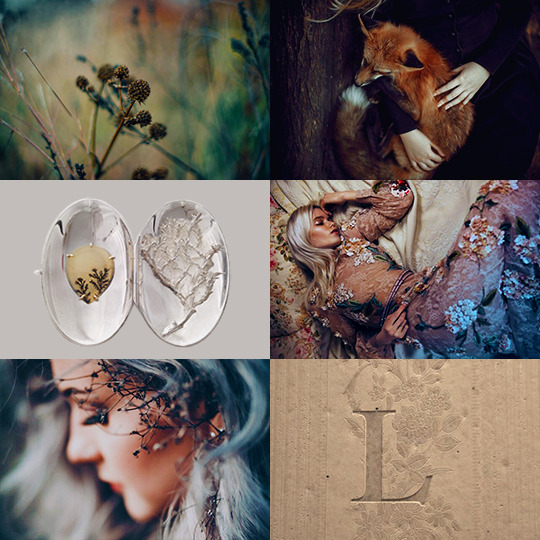#lesovikha
Note
hey! for ur myth fam: my name is faith. the mythological figures are: marzanna, iðunn, and hecate. my quote is "women like you drown oceans"
hey there - you got iðunn
2 notes
·
View notes
Photo

Mara “Mavka” Lesovikha is the enigmatic prima ballerina of the traveling dance troupe Night Movements, a secretive and strange coterie of vampire ballet dancers.
As they travel from town to town, from the Urals to the Caspian sea, they leave confusion and shattered memories behind them. Local reviewers feel confounded as they cannot remember any details of the show they just witnessed.
They do however feel so very drained and fatigued after the strangely hypnotic dance performed by Mavka and her troupe.
And everyone wakes up the next morning feeling a mixture of elation and dread.
“What did we see? Was it beautiful? Or violent?” they ask.
The authorities have yet to link the troupe with the strange string of disappearances left in their wake. No bodies are found, and no evidence is left.
But Mavka’s appetite is growing, as is the trail of dead they leave behind.
Sooner or later someone will connect the dots.
(This is the 11th vampire design from my personal project where I create characters based on the vampire clans of the White Wolf rpg "Vampire The Masquerade". All my vampires are purely fan art. None of them are official White Wolf designs. I'm only doing this for fun.) - Simon Lindwall
Artwork by: Simon Lindwall
67 notes
·
View notes
Text
Russian Fairy Tales Test Prep: Spirits of the Forests, Waters, and Fields
Like the domovoi, the spirits of the forests, waters, and fields had their origin in pre-Christian times, but the nature spirits were considered basically harmful to humans and were generally regarded as unclean. The bulk of available sources re: nature spirits dates from the end of the 19th century, when belief in these beings was already in a state of decline and information about them was often imprecise or contaminated by the addition of traits more properly belonging to the Devil.

The Leshii: master of the forest, guardian of beasts.
He could assume the likeness of a familiar person, a forest beast, a domestic animal, even a mushroom. He made his presence known to peasants venturing into his territory through laughter, handclapping, and the various sounds of the forest. It was reported that he could “sing without words.” He would frequently “prank” peasants by calling to them in a familiar voice so they would get lost in a deep thicket or ravine. Sometimes he would tickle people to death. At all times, it was considered essential to utter a protective prayer upon entering the forest. The leshii hated boisterous conduct, sojourns in the woods at night, and woodcutters. He wailed if one of his favorite trees was chopped down.
Historical basis: In medieval Russia, it was customary to cut off a robber’s left ear after the first offense. The peasants had a tendency to refer to the forest spirit as kornoukhii (”one whose ear has been cut off”). In Karelia, Russians often pictured forest spirits wearing military uniforms, indicating that peasants assigned them traits of fugitive soldiers hiding in the forest. Similarly, narratives in which the leshii approaches a campfire and requests food may reflect this practice among vagabonds and escaped serfs seeking refuge in the forest.
Social organization: While there was usually one leshii per forest, sometimes there were several. For particularly large forests, the notion existed that there was a hierarchy of forest spirits, ruled by a tsar. Forest spirits feasted and played games together. The leshii lived with his wife, his children, and sometimes his mother & father. Their domestic order was imagined as similar to that of the peasants; they lived in houses, had dogs, and raised livestock. In certain areas, the leshii’s wife, the lesovikha, played a prominent role in forest lore.
Dealings with humans: Among the forest beasts, the wolf was the leshii’s favorite, and on occasion the spirit assumed the form of a large white wolf. Throughout the woodlands of Great Russia, peasants took measures to guard their cattle from the leshii’s wolves. Many of them called on St. George’s protection from predators.
In the Russian North, where cattle were pastured in the forest, peasants also solicited the leshii’s protection. This sometimes took the form of a pact between the forest spirit & the herdsman, who (according to one account) concluded this agreement much the same way that sorcerers concluded pacts with the devil: he removed his cross from his neck, swore fidelity to the forest spirit, and instead of swallowing holy communion, handed it over to the leshii. Peasants often looked askance at herdsmen (and at hunters, who made similar pacts), suspecting they possessed occult powers.

Leshie also carried off young girls, who they sometimes married, and women living in discord with their husbands. Narratives tell of peasant women abducted or summoned to serve as nannies or midwives for the forest spirit. One occasionally encounters the idea that captives could gain their freedom by refusing to eat the leshii’s food. Those who returned from the forest were reportedly wild-looking and covered with moss, and often they could no longer speak. Many never recovered, remaining in a state of continual distraction for the rest of their lives. Some made use of the knowledge of the unclean force gained by their forest experience and became sorcerers.

The Vodianoi
- often referred to as “the water devil”
- universally considered evil & dangerous, since his sole purpose was drowning people
Habitat: The vodianoi lived underwater in deep pools. He confined himself to his own & neighboring waters, coming out only as far as the bank or the mill wheel. In some areas, it was believed that the vodianoi did not leave the water at all, but emerged only as far as his waist.
In the black-earth provinces of Riazan, Tula, Orel, and Kaluga, peasants claimed that the spirits had magnificent underwater palaces of crystal and that they gave grand feasts. Peasants from northern areas (such as Olonets) had a more modest conception of the spirits’ dwellings: here the silver floors, golden ceilings, and crystal chandeliers of their southern kin are replaced by sandy bottoms, snarled branches, and slimy logs.
Relationships: The vodianoi married a drowned maiden, either a rusalka or his female counterpart (the vodianikha), who was envisioned as a naked woman with gigantic breasts sitting on the bank at night, combing her long wet hair.
The vodianoi liked millers & fishermen; the miller in particular was often regarded with suspicion because of his relationship with the spirit. When a new mill was constructed, a black rooster was placed under the threshold as an offering to the vodianoi. If you really wanted to impress him, you could drown a drunk passerby instead of a rooster, maybe even as an annual sacrifice. That was said to be worthy of a standing invitation to the spirit’s nightly underwater feast.

The Polevoi & Poludnitsa: spirits of the field.
In some places, the polevoi was considered an oracle, and thus morally neutral. In other places, they were a sign of misfortune, considered unclean and dangerous. According to folk notions, it was dangerous to sleep on the boundaries of the field because the polevoi liked to gallop there and might run you over with his horse. His children also played there and liked to smother sleeping humans.
In some regions, one finds mention of a female field spirit known as the poludnitsa or “midday spirit” AKA Lady Mid-day, who may have played an important role in folk belief during medieval times. Back then, she was believed to walk the fields at noon when the grain was ripe. Her function was to protect the crop and to punish peasants caught working at noon (in violation of custom) by breaking their bones and twisting their necks.

The Rusalka: female spirits, thought to be the souls of unbaptized/stillborn babies and drowned maidens.
alternate names for her: “jokestress” (shutovka), “tickler” (loskotukha), “abductor” (khitka), and among the Northern Great Russians, “demoness” (chertovka).
alternate origins:
1. Some creation legends claimed that the devil himself fashioned the spirits (both domestic AND natural) when, imitating God, he struck one rock against the other. The fragments became these creatures.
2. One legend claims that these spirits were children whom Adam (or Noah) was ashamed to show to God and thus hid.
3. Vodianye & rusalki were thought to be descended from Pharoah’s forces, drowned while pursuing Moses across the Red Sea.
4. In Kaluga Province, it was believed that they received their eternal youth and beauty directly from the Devil, who boiled them in a cauldron.
5. Only in Bulgaria was the rusalka portrayed positively; rusalki were understood as winged spirits who lived on the edge of the world and brought moisture & fertility.
All but the last of these explanations bear the stamp of apocryphal legends based on the Old Testament, illustrating the grafting process of dvoeverie.
These spirits were considered especially dangerous in the late spring during Rusal’naia Week, when they supposedly left their underwater homes from the forests & fields. Peasant women sometimes hung offerings of scarves and linen on forest trees to appease them. Reports sometimes specified that the rusalki did not like women; on the other hand, they often told of love between these spirits and village lads.
Most accounts of the rusalki paint this picture: sisterhoods of lovely maidens in league with the unclean force. This is the standard image for Southern Great Russia & the Ukraine, an image highly evocative in its interweaving of beauty and treachery.

19 notes
·
View notes
Photo

The Leshy (Russian: Ле́ший; literally, "[he] from the forest", Polish: Boruta, Leszy) is a tutelary deity of the forests in Slavic mythology. The plural form in Russian is лешие, leshiye (retaining the stress on the first syllable). As the spirit rules over the forest and hunting, he may be related to the Slavic god Porewit.
Leshy are masculine and humanoid in shape, are able to assume any likeness and can change in size and height.He is sometimes portrayed with horns and surrounded by packs of wolves and bears. In some accounts, Leshy is described as having a wife (Leshachikha, Leszachka, Lesovikha) and children (leshonki, leszonky). He is known by some to have a propensity to lead travelers astray and abduct children, (which he shares with Chort, the "Black One") which would lead some to believe he is an evil entity. He is however also known to have a more neutral disposition towards humans, dependent on the attitudes and behaviours of an individual person, or local population, towards the forest. Some would therefore describe him as more of a temperamental being like a fairy.
867 notes
·
View notes
Note
How do you make your moodboards?
I usually pick the moodboard topic (like the Slavic forest spirit lesovikha or Noah the name etymogy) and write down the imagery and colour theme I associate the theme with. Then I just create a file folder or a Pinterest board where I collect photos that go nicely together and fit the imagery. I pop them into Photoshop (crop them, play around with the colouring, nothing big) and that's the whole process! 🌞
0 notes
Photo

The Leshy (Russian: Ле́ший; IPA: [ˈlʲeʂɨj]; literally, "[he] from the forest") is the tutelary spirit of the forests in Slavic folklore. The plural form in R
ussian is лешие, which can be transliterated leshiye (retaining the stress on the first syllable).
Leshiye are masculine and humanoid in shape, are able to assume any likeness and can change in size and height.
In some accounts, the leshy is described as having a wife (leshachikha/leszachka/lesovikha) and children (leshonki/leszonky).
#hetalia#Axis Powers Hetalia#Axis powers ヘタリア#aph russia#leshy#slavic mythology#slavic folklore#ivan braginsky
6 notes
·
View notes
Photo

#Leshak #Leshii #Leshiye #Leshonki #Lesnoi #Lesovik #Lychie These are forest spirits who are green and lead travellers of their track. A male Leshii has the form of a man with a green beard and long shaggy hair. He has green eyes, cast no shadow and wears boots on the wrong foot. He is also regarded as the guardian of wild animals of the forest. During Winter they would hide and remain calm. In Spring they can be heard howling and would fight with themselves causing storms and rain in hope to bring Autumn quickly and ruin Spring. However the rains and storms soon ended. Each forest has its own family with a wife known as Lesovikha and children known as Leshonki. They lead travellers through the forest in the wrong direction until they were thoroughly lost or were stuck in a bog. The spirit would then disappear leaving the traveller in despair. To ward off the troublesome Leshii it is advised to carry some bread to give as a gift or to wear one’s clothes inside out until one reaches the end of the forest.
0 notes
Photo


mythology meme | Slavic spirits & demons - lesovikha
Lesovikha is the female version and sometimes a companion of leshy, a magical protector of woodlands. The spirit's true appearance is ambigious as she's a shape-shifter and while some mortals describe her as a naked young girl as tall as a tree with green eyes and long shaggy hair or note that her body cast no shadow, others claim they've encountered her in the shape of a tiny raindrop. Lesovikha plays an important role in Slavic forest lore. She is a trickster who finds great joy in leading lone travellers astray, especially if they were caught making a fire in her forest sanctuary. Angered, she then follows these lost souls to ask what they desire most: fortune or a good life. If the travellers choose money, lesovikha rewards them with golden coins that turn into coals the moment they set foot outside her woodland realm. Hovewer, if they wish for a good life lesovikha honours her promise and the mortals enjoy success in all their endevours.
#Slavic mythology#mythology meme#lesovikha#leshy#lesovik#woodland spirit#spirits and demons#mythology#faerie#mori girl#myths and legends#flowers and floral#nature#forest witch#*
5K notes
·
View notes